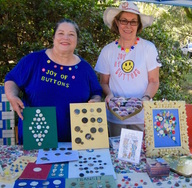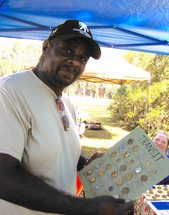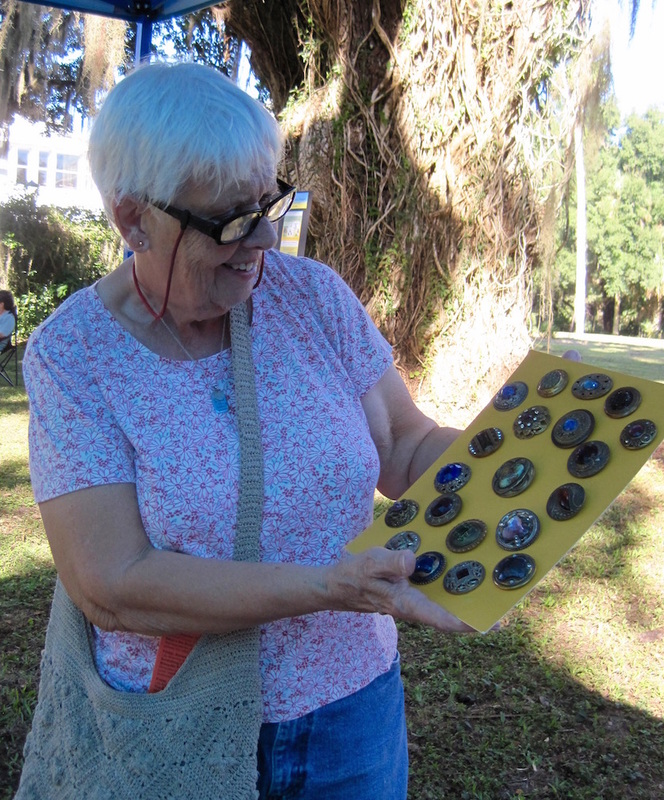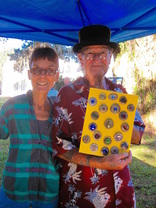|
What fun we had bringing our Hernando County Button Collectors Group information to attendees of our local native plant sale! The interest we got from people was surprising and gratifying. We hope to add some of our visitors to our group.
0 Comments
Below is a list of categories from which you can choose a favorite button(s) to bring for "Show 'N Tell" at our meetings. If there is not a website link with the description, you can try google-ing the term and add the word "images" to find photos of the type. Remember, you can also bring buttons that feature designs that include: Cats, cars, castles, clothing, crowns and more!  Cabochon: Buttons with dome-shaped, polished or unpolished cut stone or glass that looks like stone. Generally set in a metal mounting with a shank added. Calico: China buttons whose patterns resemble or are identical to the cotton fabric, calico. Nearly 600 patterns have been found. Cameos: Designs such as heads, scenes, figures on genuine cameo buttons have been cut from the upper layers of stone or shell, leaving an underlayer as the background. Molded, pressed and glass cameos are also found. We are perhaps most familiar with molded glass or composition “cameos” with head designs. Cane Trim: Rods of glass (cane) were stretched thin and place around the button to create a trim. Cane was also used to make paper-weight buttons. Caramel Glass: Opaque glass that looks like brown sugar caramel and was molded into a button with a self-shank or with a metal shank added. Carnelian: A red stone used in jewel-type buttons with a pin-head shank, mostly in the 19th century. Carving: Hand or machine cut designs on buttons. Pearl shell was carved in the 18th century. In the 19th and 20th centuries, bone, coconut shell, horn, ivory, jet, pearl shell, stone, tortoise shell, vegetable ivory and a few plastics were carved. Casein: An early plastic button. Often has the word Casein on the back. Can be black, white or of various colors. www.buttoncountry.com/SynPoly1.html Catlinite: From a clay also called “Pipestone.” Some buttons were carved and some have Native American designs painted on them. Almost all were made in the 1900s. Cat’s Eye: A gemstone or deep-sea pearl button featuring a light-colored band of light that resembles the slit pupil of a cat. Celluloid: An early plastic from which buttons were made entirely from or had a thin layer of Celluloid over metal molds. Sometimes it was used as a covering of paper, pearl or other visible materials. www.buttoncountry.com/Celluloid.html Ceramics: Date from prehistoric times, ceramic buttons are currently made by many different potters. http://www.buttoncountry.com/Ceramics1.html China Stencils or Small Chinas: Black, blue, green, brown, lavender, pink, yellow, metallic lusters added in transfer designs on 3/8” to 3/4’ mostly white or cream buttons. www.buttoncountry.com/china.html Cinnabar: A cinnabar-colored, putty-like material is built up on the surface of a wooden base for the button and then carved way and then lacquered with reddish-brown cinnabar lacquer. Carved designs include Oriental flowers, figures, and scenes and can also be gray, green, brown or black colored. Coal: Buttons made from anthracite coal from Pennsylvania. Coconut Shell: Buttons made from the hard shell of a palm tree nut. Coin buttons: Buttons can be found made from real coins or just with a coin design. Colt: The Plastics Division of the Colt Firearms Company made plastic buttons. plus.google.com/photos/101693465104657191015/albums/5647447269607856993 Commemoratives: A button issued to commemorate an important event or person. Many to be found. Composition: Buttons molded from a material made of a mixture of substances. Can be solid colors or mix of colors and some with metal, called “flecks.” Cone Shank: Used in the 18th 19th centuries the shanks feature a cone-shaped piece of metal that surrounds the loop, covering where the two loo ends are inserted into the button. Confederate: Buttons worn by the troop of the Confederate Army during the Civil War. After 1865 some were copied and for use by veterans. www.relicman.com/buttons/zArchiveButtonVeteran.htm Copper: Buttons made for at least three centuries and include many add-on decorations. After 18th century, copper in alloys most prevalent. Coral: Buttons made of distinctive pink skeleton of tiny sea creatures. More often coral is found as a decoration on buttons of other materials. Cork: Spongy other bark of the cork oak tree, that can be found in three or more shades of brown. Many buttons have metal or colored plastic added and some metal buttons have cork as a trim. Corozo Nut: Known as Vegetable Ivory buttons, but made from this nut. www.buttoncountry.com/VI-1.html Covered Type: Buttons with a metal cover over a cup-shaped wood or bone mold with the unusual cat-gut shank. Cowrie Shell: Deep-sea shell generally of white or cream color have four layers that can be used separately as backgrounds. Most commonly the tiger cowrie is used for buttons. Crochet: Needlework made by hand first became fashionable in the early 1800s, but crochet style buttons are now also manufactured. Crosses: About 40 different cross designs can be found on buttons. Crystallized Tin: This metal was treated to produce the look seen on galvanized iron pails, tubs and pipes. Can be used for the complete button face or as a center decoration on a brass button. Cut Steel: Often dazzling, these metal buttons were completely covered with steel cut into facets. Cut steel has also been used to trim buttons of other materials like horn,bone, tortoiseshell and pearl shell. Cutout Shank: 20th century shank design with the shank cut out of the metal back of the button, which is then forced up into a kind of tent shape. |
Sylvia Liszka Durell, AuthorOwner of HoleyButtons.com and a founding member of the Hernando County Button Collectors Group in Florida. Archives
June 2024
|





 RSS Feed
RSS Feed